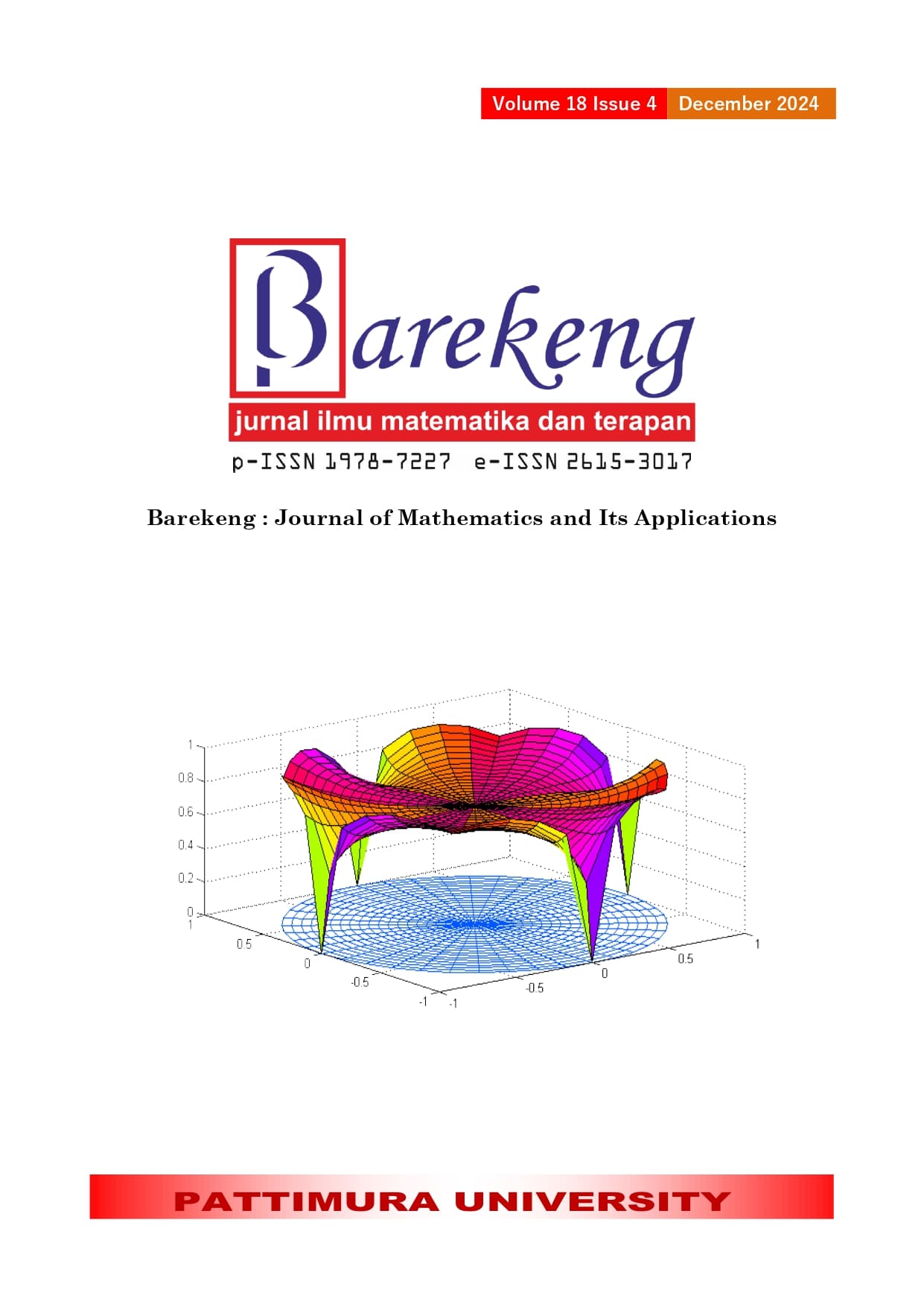MODELING THE BENEFITS OF A MARRIAGE REVERSE ANNUITY CONTRACT WITH DEPENDENCY ASSUMPTIONS USING ARCHIMEDEAN COPULA
Abstract
Social security benefits may not be enough for retirement. Equity release products like marriage reverse annuities can boost retirement income for older couples. Marriage reverse annuity’s contract convert all or part of the real estate value of elderly spouses while they are living (joint life status) or after one partner dies (last survivor status). Since husband and wife face the same death risk, the chance of death between spouses is believed to be dependent for realism. Thus, copula models the future dependency model of a husband and wife. Sklar's theorem states that copulas link bivariate distribution and marginal cumulative functions. One of the most common copulas is Archimedean copula. Clayton, Gumbel, and Frank are Archimedean copula that will be used in this investigation. The Indonesian Mortality Table IV data is used to obtain the marginal distribution of the male and female which will then be used to construct copulas (Clayton, Gumbel, and Frank) that combine two marginal distributions into a joint distribution. The marginal distribution of Indonesian Mortality Table IV is uncertain, hence Canonical Maximum Likelihood parameter estimation is utilized to estimate the parameter of copulas. Multiple-state models depict the marriage reverse annuity model for joint life and last survivor status. The probability structure is based on Sklar's theorem and copula survival function. The contract benefits calculation utilizing copulas (Clayton, Gumbel, and Frank) shows that joint life status benefits are higher than last survivor status. Joint life status uses the dependence assumption with Frank's copula to calculate the smallest annual benefit value of a marriage reverse annuity contract, while last survivor status uses the independence assumption (without copula).
Downloads
References
U. Reifner, S. Clerc-Renaud, E. F. P. Carrillo, A. Tiffe, and M. Knobloch, “Study on equity release schemes in EU. Part I: General Report,” Institut für Finanzdienstleistungen e.V., Jan. 2009.
K. HanewaldS M. Sherris, “Portfolio Choice in Retirement-What is The Optimal Home Equity Release Product?,” Journal of Risk and Insurance, vol. 83, no. 2, pp. 421–446, Jun. 2016.
A. W. Shao, K. Hanewald, and M. Sherris, “Reverse mortgage pricing and risk analysis allowing for idiosyncratic house price risk and longevity risk,” Insurance: Mathematics and Economics, vol. 63, pp. 76–90, Jul. 2015.
E. Luciano, J. Spreeuw, and E. Vigna, “Spouses’ dependence across generations and pricing impact on reversionary annuities,” Risks, vol. 4, no. 2, Jun. 2016.
J. Spreeuw, “Types of dependence and time-dependent association between two lifetimes in single parameter copula models,” Scandinavian Actuarial Journal, vol. 2006, no. 5, pp. 286–309, Sep. 2006.
E. Luciano, J. Spreeuw, and E. Vigna, “Modelling stochastic mortality for dependent lives,” Insurance: Mathematics and Economics, vol. 43, no. 2, pp. 234–244, Oct. 2008.
S. Heilpern, “Dependent Structure Induced by Markov Chain in the Multiple Life Insurance,” in 18th International Scientific Conference Application of Mathematics and Statistics in Economics, Sep. 2-6, 2015.
J. Dębicka, S. Heilpern, and A. Marciniuk, “Application of copulas to modelling of marriage reverse annuity contract,” Prague Economic Papers, vol. 29, no. 4, pp. 445–468, 2020.
R. B. Nelsen, An Introduction to Copulas, 2nd ed., New York: Springer, 2006.
C. Schölzel and P. Friederichs, “Multivariate non-normally distributed random variables in climate research-introduction to the copula approach,” Nonlinear Processes Geophysics, vol. 15, no. 5, pp. 761–772, 2008.
Z. Sharifonnasabi, M. H. Alamatsaz, and I. Kazemi, “A large class of new bivariate copulas and their properties,” Brazilian Journal Probability and Statistics, vol. 32, no. 3, pp. 497–524, 2018.
U. Cherubini, E. Luciano, and W. Vecchiato, Copula Methods in Finance, Chichester: John Wiley & Sons Ltd, 2004.
J. T. Shiau, “Fitting drought duration and severity with two-dimensional copulas,” Water Resources Management, vol. 20, no. 5, pp. 795–815, Oct. 2006.
P. K. Trivedi and D. M. Zimmer, “Copula modeling: An introduction for practitioners,” Foundations and Trends in Econometrics, vol. 1, no. 1, pp. 1–111, 2005.
H. Manner, “Estimation and model selection of copulas with an application to exchange rates,” Meteor Research Memorandum, no. 056, Jan. 2007.
ASIC, “Equity release products,” ASIC, Nov. 2005.
A. Marciniuk, “Marriage Reverse Annuity Contract and Reverse Mortgage – Application of a Generalized Model of Reversionary Annuity,” in 20th International Scientific Conference Application of Mathematics and Statistics in Economics, Aug. 30 - Sept. 3, 2017.
M. Denuit, J. Dhaene, C. Le Bailly De Tilleghem, and S. Teghem, “Measuring the Impact of a Dependence Among Insured Lifelengths,” Belgian Actuarial Bulletin, vol. 1, no. 1, pp. 18–39, Jan. 2001.
AAJI, “TABEL MORTALITAS INDONESIA IV,” AAJI, Dec. 2019.
Copyright (c) 2024 Arnhilda Aspasia Lundy, Mila Novita, Ida Fithriani

This work is licensed under a Creative Commons Attribution-ShareAlike 4.0 International License.
Authors who publish with this Journal agree to the following terms:
- Author retain copyright and grant the journal right of first publication with the work simultaneously licensed under a creative commons attribution license that allow others to share the work within an acknowledgement of the work’s authorship and initial publication of this journal.
- Authors are able to enter into separate, additional contractual arrangement for the non-exclusive distribution of the journal’s published version of the work (e.g. acknowledgement of its initial publication in this journal).
- Authors are permitted and encouraged to post their work online (e.g. in institutional repositories or on their websites) prior to and during the submission process, as it can lead to productive exchanges, as well as earlier and greater citation of published works.






1.gif)



